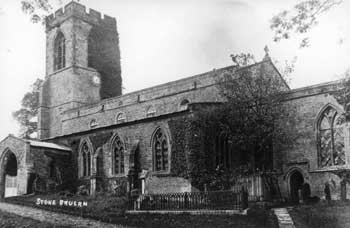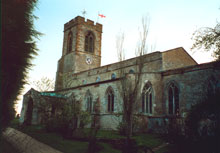|
 |
 |
 |
 |
 |
 |
 |
 |
 |
 |
 |
 |
 |
 |
 |
 |
 |
 |
 |
 |
 |
|
|
|
|
|
|
|
|
|
|
|
|
|
|
|
|
|
|
|
|
 |
 |
|
|
|
|
 |
|
|
|
|
|
|
St. Mary the Virgin Church
The Church is mainly 14 & 15th century. It consists of a body, north and south aisles and leaded chancel. There is an embattled tower at the west end with five bells; the lower part is of the twelfth century, with buttresses added later. The vestry, the most recent part of the church, was built in 1881.
|
|
|
|
|
 |
|
|
 |
|
|
|
|
 |
|
|
The first incumbert, Richard de Rof, took office in 1217 with Patron at that time being William Briwere. The lane leading to the Church is still recognisable as an ancient hollow way.
|
|
|
|
 |
|
|
|
|
|
|
|
|
|
 |
|
|
|
 |
|
|
|
RIGHT: St. Mary's Church 1915. The white wooden porch gates; the metal railings around the graves and the ivy are no longer there. The original clock dial can be seen on the tower. |
|
|
|
 |
|
|
|
The Church Bells |
|
|
|
|
 |
|
|
|
The Church Guide that the 17 & 18th century bells were probably cast from the medieval bronze bells and that in 1900 all five bells were quarter-turned, re-tuned and the wooden supports in the belfry renewed. To mark this restoration the following inscriptions were incised on the bells:
No 1. Joseph Valentine rings me 1900
No 2. William White ring me 1900
No 3. Joseph Valentine Senior rings me 1900
No 4. Frank Valentine rings me 1900
No 5. To the glory of God this peel of bells were quarter turned and completely restored as well as the belfry in the year of Our Lord 1900 by Bertie and Isabel Wentworth Vernon. William Tew rings me 1900. |
|
 |
|
|
|
|
 |
|
|
|
|
|
|
|
|
|
|
|
|
ABOVE: Two of the bells removed from the belfry |
|
|
 |
|
|
By 1970 the bells could not be rung with bell No. 3 cracked and needing to be recast; also the floor in the belfry was in poor condition. An appeal fund was launched for the restoration of the bells.
The repair of the bells coincided with the replacement of floors in the Museum and the best of these timbers were used in the church tower.
The bells were returned to Stoke Bruerne on 8 March 1976, rehung, and dedicated by Bishop Rogers on the 28 March. |
|
|
|
 |
|
|
|
|
|
|
|
|
|
|
|
|
|
|
|
 |
|
|
|
 |
|
|
 |
|
|
|
|
|
|
|
|
 |
|
|
|
RIGHT: A picture showing the tower from the West. The second clock face was introduced when the new clock mechanism was installed for the Millennium. |
|
|
|
 |
|
|
ABOVE: A contempory picture taken from the East. Compare this with the 1915 picture above. |
|
|
|
|
|
|
|
|
 |
|
|
The Churchyard |
|
|
|
|
|
|
|
|
|
|
|
 |
|
|
On one of the two pillars flanking the gate to the west of the churchyard the following inscription can be seen:- |
|
|
|
|
 |
|
|
|
|
|
This has been interpreted as follows:-
Anno Domini 1893
ParsoN GavE (permission to erect. The Rev. Spedding Wilson gave land off the Glebe)
WardeN DravE (carried the materials by horse and cart. Wardens T. Young & G.Savage)
ClerK MadE (a typical job for the village sexton, Mr Thomas Tew)
SqirE PaiD (the accepted thing for a good squire to do: Squire Vernon duly paid)
God Save The Queen
To Our One God |
|
|
 |
|
|
A . . . . 1893 . . . . D
P N . . . . . . . . . . G E
W N . . . . . . . . . D E
C K . . . . . . . . . . M E
S E . . . . . . . . . . . P D
G S T Q
T O O G
|
|
|
|
 |
|
|
The white marble obelisk War Memorial, near to the church porch, is one of the few in the country which includes the name of a woman. The lead inscription reads: Sister Elsie Bell, who is buried in the churchyard, nursed victims of World War I in France, and also in Serbia, where she faced the dangers of a typhus epedemic. She was the daughter of a coachman at Stoke Park. |
|
 |
|
|
MILLENNIUM PROJECT
To Celebrate 2000 Years of Christianity a £24,000 project was undertaken to Floodlight the Church and reinstate the clock, not just on the East face of the tower but an additional dial on the more visible West side. Both projects were completed by December 1999, just in time to celebrate the Millennium.
|
|
|
|
 |
|
 |
|
|
|




